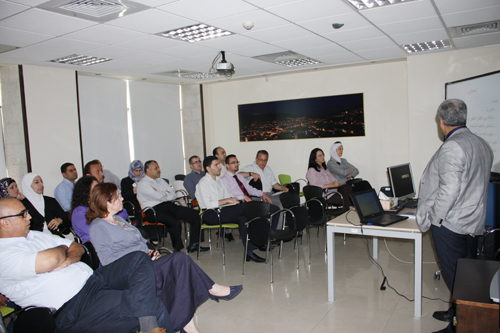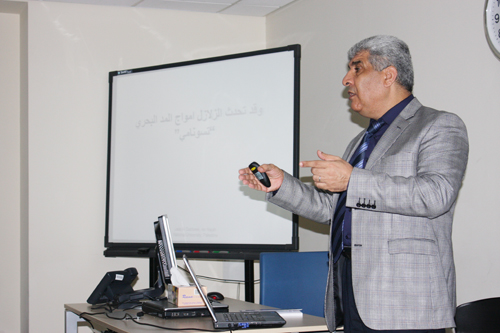Dr. Jalal Dabbeek Lectures at the Palestine Exchange about Disaster Risk Reduction
On September 27th, Dr. Jalal Dabbeek, Director of the Urban Planning and Disaster Risk Reduction Center at An-Najah, delivered a lecture about the issue of disaster risk reduction at Palestine Exchange in Nablus. The lecture targeted all the employees at the Exchange.

In his lecture Dr. Dabbeek spoke about the concept of disaster risk reduction and UN-ISDR objectives, the Arab Strategy for Disaster Risk Reduction 2011-2020 and explained that disasters, whatever they are, should not be faced by a mere response or speeches but through enforcing laws and regulations that deal with the disaster extensively. Clear strategies must be laid down and disasters should be considered a national priority based on a solid, executable institutional platform. He also discussed the general framework of the Arab and International strategies.
Moreover, Dr. Dabbeek said in order to achieve this it is necessary to be prepared to deal with a disaster before it occurs through updated studies, continuous observation, as well as proper diagnosis of the disaster before, during and after it takes place. These things can be achieved through developing knowledge, sound judgment, innovative methods to avoid damage such as earthquake design of buildings and developing the emergency response capabilities, etc.
Additionally, Dr. Dabbeek tries to establish a relationship between the size and types of investment and the availability of a good context for this purpose explaining that countries that witness frequent floods, storms, hurricanes, volcanoes or earthquakes is the weak link when it comes to investment since the frequent occurrence of such disasters makes it very risky for people to invest in these countries.
He also pointed out that technology is a double-edged sword meaning that while technology has made life easier for human beings, it resulted in urban and civilization expansion that led to mega cities to be located on the danger zones around the world maximizing the chances for more fatalities to fall in case a certain disaster takes place.

In the second part of his lecture, Dr. Dabbeek presented a general diagnosis of the possibility for an earthquake to take place in the region and the maximum severity and strength of such event if it occurs. He also shed light on the most prominent and significant mistakes found in constructions and buildings in Palestine and to what extent these constructions are considered earthquake-proof. He also explained that in order to reduce the risks of potential seismic events, there is an aching need to abide by the requirements of safe cities which demands commitment on the part of the local institutions and municipalities to the regulations and standards adopted by the concerned UNISDR.
Furthermore, Dr. Dabbeek explained the methods used to deal with disasters when they take place such as how to locate the injured, secure temporary residence for the homeless, set long-term housing plans, provide information centers regarding the injured, secure emergency roads, in addition to securing a media operation room to guarantee communication and contact between the different local and international bodies.



